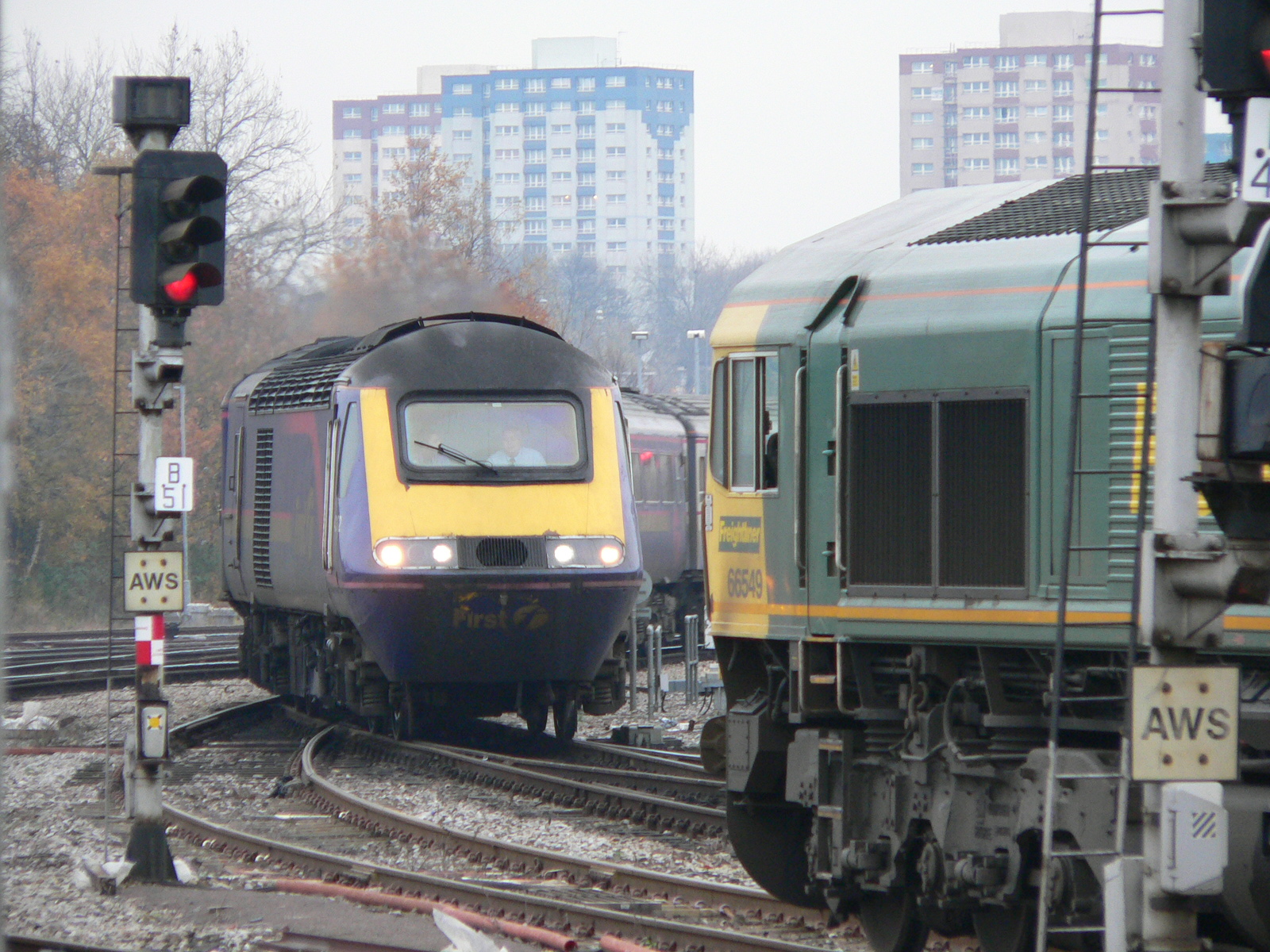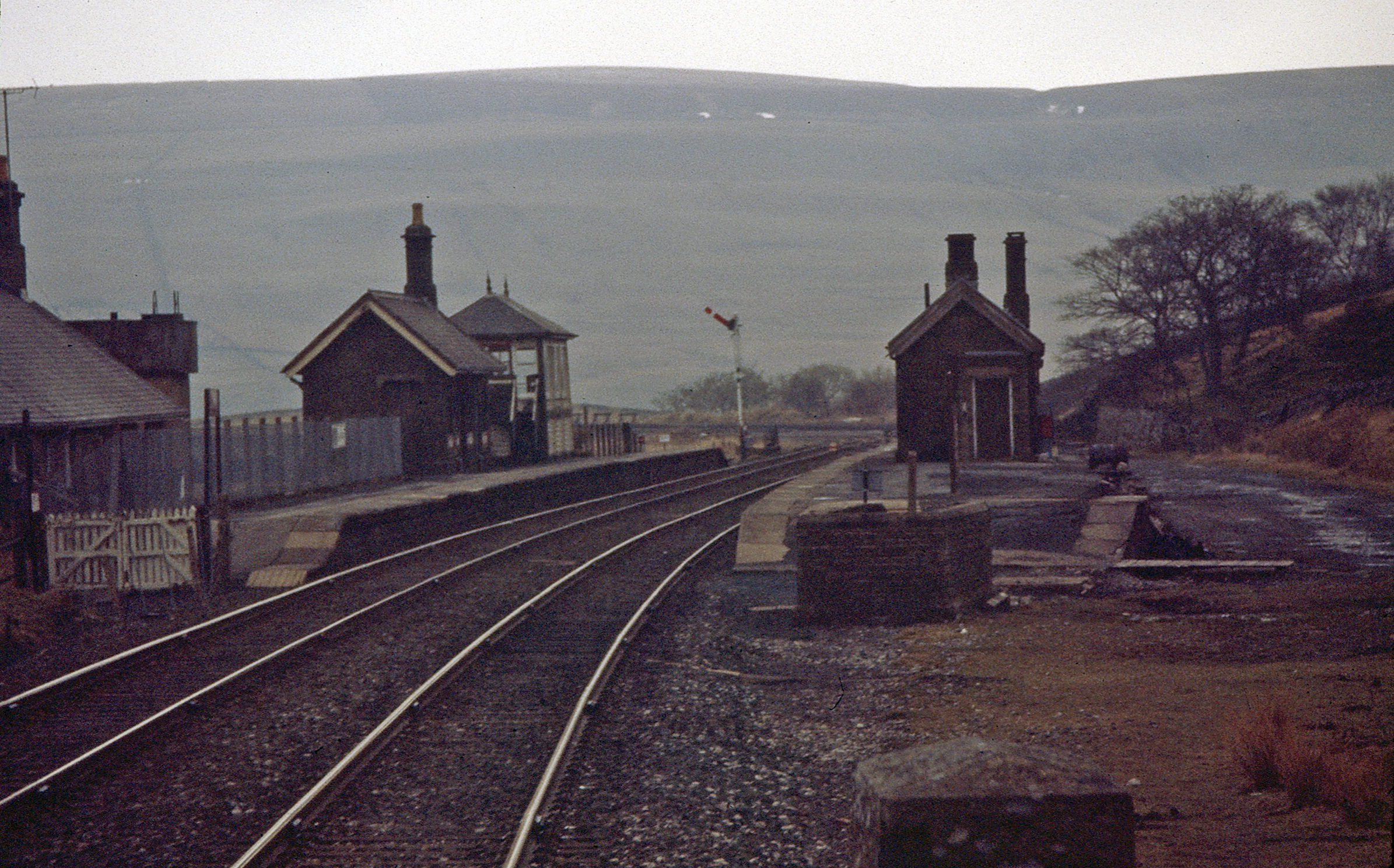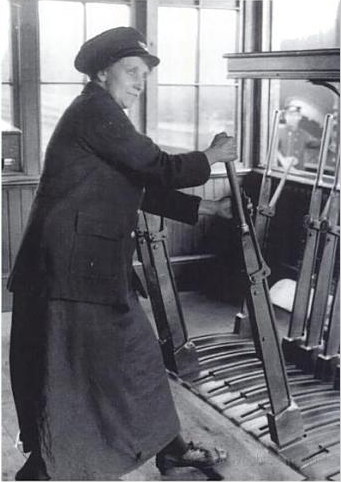|
Treadle (railway)
In railway signalling, a treadle is a mechanical or electrical device that detects that a train wheel has passed a particular location. They are used where a track circuit requires reinforcing with additional information about a train's location, such as around an automatic level crossing, or in an annunciator circuit, which sounds a warning that a train has passed an exact point. They also serve as a critical backup in the case of track circuit failure. The important difference between a treadle and a track circuit is that while a track circuit detects a train over a distance as long as several kilometres, a treadle provides detection at a single fixed location. Types Mechanical In situations where track circuits are unreliable due to rusty rails, for example adjacent to buffer stops and catch points, a long treadle bar is used. When this is depressed, the signaller gains indication (if they have not already done so) of a train in a section. Electro-Mechanical An electro-mec ... [...More Info...] [...Related Items...] OR: [Wikipedia] [Google] [Baidu] |
Rail Treadle
Rail or rails may refer to: Rail transport *Rail transport and related matters *Railway track or railway lines, the running surface of a railway Arts and media Film *Rails (film), ''Rails'' (film), a 1929 Italian film by Mario Camerini *Rail (1967 film), ''Rail'' (1967 film), a film by Geoffrey Jones for British Transport Films *Rail (2024 film), ''Rail'' (2024 film), a Tamil-language film Magazines *Rail (magazine), ''Rail'' (magazine), a British rail transport periodical *Rails (magazine), ''Rails'' (magazine), a former New Zealand based rail transport periodical Other arts *The Rails, a British folk-rock band *Rail (theater) or batten, a pipe from which lighting, scenery, or curtains are hung Technology *Rails framework or Ruby on Rails, a web application framework *Rail system (firearms), a mounting system for firearm attachments *Front engine dragster *Runway alignment indicator lights, a configuration of an approach lighting system *Rule Augmented Interconnect Layout, a ... [...More Info...] [...Related Items...] OR: [Wikipedia] [Google] [Baidu] |
Railway Signalling
Railway signalling (), or railroad signaling (), is a system used to control the movement of railway traffic. Trains move on fixed rails, making them uniquely susceptible to collision. This susceptibility is exacerbated by the enormous weight and inertia of a train, which makes it difficult to quickly stop when encountering an obstacle. In the UK, the Regulation of Railways Act 1889 introduced a series of requirements on matters such as the implementation of interlocked block signalling and other safety measures as a direct result of the Armagh rail disaster in that year. Most forms of train control involve movement authority being passed from those responsible for each section of a rail network (e.g. a signalman or stationmaster) to the train crew. The set of rules and the physical equipment used to accomplish this determine what is known as the ''method of working'' (UK), ''method of operation'' (US) or ''safe-working'' (Aus.). Not all these methods require the use of p ... [...More Info...] [...Related Items...] OR: [Wikipedia] [Google] [Baidu] |
Track Circuit
A track circuit is an electrical device used to prove the absence of a train on a block of rail tracks to control railway signals. An alternative to track circuits are axle counters. Principles and operation The basic principle behind the track circuit lies in the connection of the two rails by the wheels and axle of locomotives and rolling stock to short an electrical circuit. This circuit is monitored by electrical equipment to detect the absence of the trains. Since this is a safety appliance, fail-safe operation is crucial. Hence the circuit is designed to indicate the presence of a train when failures occur. On the other hand, false occupancy readings are disruptive to railway operations and must be minimized. Track circuits allow railway signalling systems to operate semi-automatically, by displaying signals for trains to slow or stop in the presence of occupied track ahead of them. They help prevent dispatchers and operators from causing accidents, both by informin ... [...More Info...] [...Related Items...] OR: [Wikipedia] [Google] [Baidu] |
Level Crossing
A level crossing is an intersection where a railway line crosses a road, Trail, path, or (in rare situations) airport runway, at the same level, as opposed to the railway line or the road etc. crossing over or under using an Overpass#Railway, overpass or tunnel. The term also applies when a light rail line with separate Right-of-way (railroad), right-of-way or reserved track crosses a road in the same fashion. Other names include railway level crossing, railway crossing (chiefly international), grade crossing or railroad crossing (chiefly American), road through railroad, criss-cross, train crossing, and RXR (abbreviated). There are more than 100,000 level crossings in Europe and more than 200,000 in North America. Road-grade crossings are considered incompatible with high-speed rail and are virtually non-existent in European high-speed train operations. File:The 5.20 for West Kirby leaving Hoylake - geograph.org.uk - 1503619.jpg, A level crossing at Hoylake, Merseyside, Engl ... [...More Info...] [...Related Items...] OR: [Wikipedia] [Google] [Baidu] |
Buffer Stop
A buffer stop, bumper, bumping post, bumper block or stopblock (US), is a device to prevent Railroad car, railway vehicles from going past the end of a physical section of Track (rail transport), track. The design of the buffer stop is dependent, in part, on the kind of couplings that the railway uses, since the Railway coupling, coupling gear is the first part of the vehicle that the buffer stop touches. The term "buffer stop" is of Italian origin, since railways in Italy principally use Buffers and chain coupler, buffer-and-screw couplings between vehicles. Types Several different types of buffer stop have been developed. They differ depending on the type of coupler used and on the intended application. * Buffer stops with anticlimbers. These are particularly important for passenger railway applications, because the anticlimbers reduce the likelihood of Telescoping (railway), telescoping of the Passenger car (rail), railroad cars during a head-on impact. * Buffer stops for ... [...More Info...] [...Related Items...] OR: [Wikipedia] [Google] [Baidu] |
Catch Points
Catch points and trap points are types of railroad switch, points which act as railway safety devices. Both work by guiding railroad car, railway carriages and trucks from a dangerous route onto a separate, safer track. Catch points are used to derailment, derail vehicles which are out of control (known as Runaway train, ''runaways'') on steep slopes. Trap points are used to protect rail terminology#M, main railway lines from unauthorised vehicles, moving onto them from rail siding, sidings or branch lines. Either of these track arrangements may lead the vehicles into a sand drag or safety siding, track arrangements which are used to safely stop them after they have left the main tracks. A derail is another device used for the same purposes as catch and trap points. Trap points ''Trap points'' are found at the exit from a rail siding, siding or where a secondary track joins a main line. A facing and trailing, facing turnout is used to prevent any unauthorised movement that ... [...More Info...] [...Related Items...] OR: [Wikipedia] [Google] [Baidu] |
Axle Counter
An axle counter is a system used in railway signalling to detect the clear or occupied status of a specified section of track. The system generally consists of a wheel sensor (one for each end of the section) and an evaluation unit for counting the axles of the train both into and out of the section. They are often used to replace a track circuit. Principles and operation An axle counter consists of a sensor, which detects the individual axles of a train by mechanical, electrical or even fibre optic method, and an evaluator which counts the axles passing into and out of a rail section. The evaluator may also convert the analogue signal of the axle sensor into a digital signal. However, in some cases there is a separate unit which performs this task. The system is set up by having an axle counter sensor installed at each end of a section. As each train axle passes the axle counter sensor at the start of the section, a counter increments. An axle counter sensor comprises two in ... [...More Info...] [...Related Items...] OR: [Wikipedia] [Google] [Baidu] |
Railway Signal
A railway signal is a visual display device that conveys instructions or provides warning of instructions regarding the driver's authority to proceed. The driver interprets the signal's indication and acts accordingly. Typically, a signal might inform the driver of the speed at which the train may safely proceed or it may instruct the driver to stop. Application and positioning of signals Originally, signals displayed simple stop or proceed indications. As traffic density increased, this proved to be too limiting and refinements were added. One such refinement was the addition of distant signals on the approach to stop signals. The distant signal gave the driver warning that they were approaching a signal which might require a stop. This allowed for an overall increase in speed, since train drivers no longer had to drive at a speed within sighting distance of the stop signal. Under timetable and train order operation, the signals did not directly convey orders to the tr ... [...More Info...] [...Related Items...] OR: [Wikipedia] [Google] [Baidu] |
New South Wales
New South Wales (commonly abbreviated as NSW) is a States and territories of Australia, state on the Eastern states of Australia, east coast of :Australia. It borders Queensland to the north, Victoria (state), Victoria to the south, and South Australia to the west. Its coast borders the Coral Sea, Coral and Tasman Seas to the east. The Australian Capital Territory and Jervis Bay Territory are Enclave and exclave, enclaves within the state. New South Wales' state capital is Sydney, which is also Australia's most populous city. , the population of New South Wales was over 8.3 million, making it Australia's most populous state. Almost two-thirds of the state's population, 5.3 million, live in the Greater Sydney area. The Colony of New South Wales was founded as a British penal colony in 1788. It originally comprised more than half of the Australian mainland with its Western Australia border, western boundary set at 129th meridian east in 1825. The colony then also includ ... [...More Info...] [...Related Items...] OR: [Wikipedia] [Google] [Baidu] |
Hawes Junction Rail Crash
The Hawes Junction rail crash occurred at 5.49 am on 24 December 1910, just north of Lunds, North Yorkshire, Lunds Viaduct between Garsdale railway station, Hawes Junction (now known as Garsdale station) and Aisgill on the Midland Railway's Settle and Carlisle main line in the North Riding of Yorkshire (now Cumbria), England. It was caused when a busy signalman, Alfred Sutton, forgot about a pair of light engines waiting at his down (northbound) starting signal to return to their shed at Carlisle, Cumbria, Carlisle. They were still waiting there when the signalman set the road for the down Scotch express. When the signal cleared, the light engines set off in front of the express into the same block section. Since the light engines were travelling at low speed from a stand at Hawes Junction, and the following express was travelling at high speed, a collision was inevitable. The express caught the light engines just after Moorcock Tunnel near Aisgill summit in Mallerstang and was al ... [...More Info...] [...Related Items...] OR: [Wikipedia] [Google] [Baidu] |
Flange Greaser 296
A flange is a protruded ridge, lip or rim, either external or internal, that serves to increase strength (as the flange of a steel beam such as an I-beam or a T-beam); for easy attachment/transfer of contact force with another object (as the flange on the end of a pipe, steam cylinder, etc., or on the lens mount of a camera); or for stabilizing and guiding the movements of a machine or its parts (as the inside flange of a rail car or tram wheel, which keep the wheels from running off the rails). Flanges are often attached using bolts in the pattern of a bolt circle. Flanges play a pivotal role in piping systems by allowing easy access for maintenance, inspection, and modification. They provide a means to connect or disconnect pipes and equipment without the need for welding, which simplifies installation and reduces downtime during repairs or upgrades. Additionally, flanges facilitate the alignment of pipes, ensuring a proper fit and minimizing stress on the system. Plum ... [...More Info...] [...Related Items...] OR: [Wikipedia] [Google] [Baidu] |
Signalman (rail)
A signalman or signaller is an employee of a railway transport network who operates the points and signals from a signal box in order to control the movement of trains. History The first signalmen, originally called Railway Policemen (leading to the nickname of 'Bobby'), were employed in the early 19th century and used flags to communicate with each other and train drivers. The railways were already in existence by then and The British Transport police say that,"early railway policemen were probably sworn in as special constables under a statute passed in 1673 during the reign of Charles II. They were appointed to preserve law and order on the construction site of the railway patrol and protect the line control of the movement of railway traffic.) and hourglasses for the purpose of Time Interval Working between stations.) In South Africa, a local rail signaller named Jack achieved some fame for the unique distinction of being a chacma baboon. Additional duties It was a ... [...More Info...] [...Related Items...] OR: [Wikipedia] [Google] [Baidu] |









